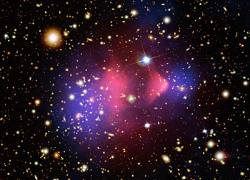Two X-Ray satellites have been studying one of the largest galaxy collisions in the Universe, gathering evidence that these clusters can collide much faster than astronomers previously believed.
Images of galaxy cluster Abell 576 were captured by NASA’s Chandra X-ray observatory, and ESA’s XMM-Newton observatory. Researchers found that there was a distinct difference in velocity of the gas; one part of the cluster seemed to be moving away faster than the other.
Fast moving gas isn’t a mystery. But the gas was very cold by astronomical standards: a mere 50 million degrees C. Gas moving this should be heated up to double that temperature.
To answer this mystery, the researchers realized that it’s all about perspective. We’re seeing Abell 576 head on. From our point of view, one cluster is almost directly behind the other. The cold clouds of gas are the cores of each cluster which had survived the initial collision, but will now fall back in for another merger. Eventually, it’ll all become one large cloud.
Original Source:ESA Portal

